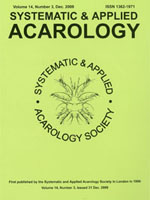The predatory mites of the family Phytoseiidae are the most important mites for use in the biological control of phytophagous mites and small insects such as thrips and whiteflies (Gerson et al. 2003). The family is the biggest in the Mesostigmata. Moraes et al. (2004)'s revised catalog of the Phytoseiidae includes 2250 species. Chant & McMurtry (2007) estimated 2280 species worldwide.
Wu et al. (2009)'s new monograph on the Phytoseiidae of China includes detailed accounts of 280 species from China and 35 of these are new species. The new volume is developed, expanded and updated from an earlier volume on the Phytoseiidae in the Economic Insect Fauna of China (Wu et al. 1997), which included 159 species (see table 1 for detailed comparisons). Although published in 2009, the manuscript of the new book was completed and submitted to Fauna Sinica at the end of 2002 and the system of classification used in the book was based mostly on the conservative system of Ehara and Amano (1998). The authors, in a note attached to the preface of the book (p. iii) in 2008, indicated that they had seen a series of reviews by Chant and McMurtry published in the Interantional Journal of Acarology during 2003–2006 and also the world catalog by Moraes et al. (2004), but they regret that they were not able to cite and use the new systems of classification in these papers in the new book.
The volume includes the following main sections: Preface, General account, Systematic account, References, English abstract, Chinese name index, Scientific name index, Appendix and Plates.
The General account (pp. 1–60) includes: a brief discussion of the etymology; a review of the taxonomic systems of the Phytoseiidae used by various authors (up to 1998); descriptions of the external morphology and internal anatomy; analysis of the distribution of phytoseiid species in China; discussions of various aspects of the biology such as life cycle and development, mating and oviposition, sex ratio, diapause and hibernation, feeding habits, relationships with spider mites, pesticide resistance and use of pesticide-resistant varieties of mites in pest management, conservation and utilization; reviews of economic importance and use in pest control; methods for rearing and storage; and methods for collecting, preserving and preparing phytoseiids for study.
The Systematic account comprises the bulk of the book (pp. 62–431). For each family-group or genus-group taxon, a list of synonyms and a diagnosis were provided, along with a key to subtaxa within each taxon. In this book, Wu et al. recognized three subfamilies, 15 genera (8 subgenera) and 41 species groups from China. For each species, the following was provided: a list of synonyms if any, descriptions of adult females and/or males with line-art illustrations, a list of host plants/ habitats, distribution within China (to the province level), taxonomic remarks if any, discussions on biology and use in biological control (if known).
The list of references (pp. 432–454) includes over 390 papers. A notable improvement in presentation of papers published in Chinese is that all these are listed in English with Chinese in brackets at the end. This makes these accessible to readers who do not understand Chinese.
The detailed English abstract (p. 455–485) is also most useful to those who do not read Chinese. This section includes keys to subfamilies, genera, species groups and species. Diagnoses of all new species are also included.
The Chinese name index (pp. 486–491) and scientific name index (pp. 492–497) include family, genus and species-group names and make it easy for readers to find names used in the volume.
The Appendix (pp. 498–500) lists 27 species known from China but not fully described in this volume due to the lack of specimens or references. So in total, 307 species of the Phytoseiidae are known from China according to Wu et al. (2009).
Pages 501–511 are two lists of all Fuana Sinica volumes in Chinese and English.
At the end of the book, there are eleven plates. The first five plates are SEM photos of morphology of selected species, and the seven in colour are selected species in habitats.
This new volume is a significant improvement over the last volume by Wu et al. (1997) in many aspects (Table 1) and the addition of a detailed summary in English is especially good for colleagues outside China. The addition of a detailed geographical tabulation of each species by province in China (outside China by countries for neighboring nations and by continents for other regions) is also most welcome. The tabular format of species distribution is an advantage in that the total number of genera and species from each province or region is easily summarized and the distribution of each species and genera can be easily compared. It is a pity that the authors just gave the tables but made no further analyses of the data (although they provided a brief summary of the data on page 21) and thus this section lacks, for example, some of the zoogeographical results that could be summarized and should be of interest to readers: for example, that among the 280 species, 204 (72.9%) are endemic to China.
Since the date of publication is important for nomenclatural reasons, it should be noted that this book was published in April 2009, without date (so the publication date should be 30 April 2009). The stated printing run is 1000.
The book is without doubt one of the most important volumes published on the Phytoseiidae to date. This large book is finished in strong cloth-binding. At the list price of RMB 138 (approximately US$20), it is very affordable for a book of this size and importance. I highly recommend this book to students of the Phytoseiidae and others interested in biological control using phytoseiids.
TABLE 1.
Comparisions of Wu et al. (1997) and Wu et al. (2009).







